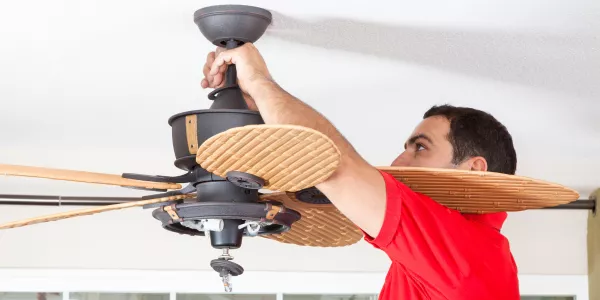Ceiling fans provide comfort by circulating air and can help reduce energy costs. Not unlike other appliances, they have a lifespan, and eventually need to be replaced. We will explore the steps to replacing a ceiling fan and clarify how long a ceiling fan should last.
How Do I Know if My Ceiling Fan Needs Replacing?
Before explaining the replacement process, let’s determine if your ceiling fan needs replacing or just some touching up. Be on the lookout for the following signs your ceiling fan needs an upgrade:
1. Noise and Wobbling
Excessive wobbling and noise could be a sign of worn-out or damaged internal components. This can affect not only the fan's performance, but safety.
2. Inefficient Airflow
A decrease in airflow, or uneven distribution, may be the result of a worn-out motor or blade issues.
3. Visible Wear and Tear
Visible wear, rust, or damage are things to look out for, too. Cracked blades or a rusty housing can impact not only the fan's aesthetics but functionality.
4. Electrical Problems
Flickering lights, sparks, or a non-responsive remote control, might be signs that it's time to consider a replacement.
5. Outdated Design
You might just want to replace your ceiling fan because it doesn’t match your decor anymore. Maybe you desire a more modern look and additional features like remote control or smart home integration? It is not uncommon to want upgrades.
How Long Does a Ceiling Fan Last?
How long a ceiling fan lasts depends on various factors, including the quality of the fan, usage, and maintenance. On average, a well-maintained ceiling fan lasts 10 to 15 years. However, some can last longer or shorter, depending on quality.
Another important factor in the longevity of your ceiling fan is its maintenance. If you regularly maintain your fan by cleaning the blades, oiling the motor and tightening the screws, you can increase the lifespan of your ceiling fan. That said, if there are signs of wear already, it might be a good time to consider a replacement.
Can You Replace a Ceiling Fan on Your Own?

If you have some electrical and mechanical skills, you might be able to take on the challenge of replacing your fan yourself. Regardless of your experience, never forget to keep safety guidelines in consideration and do your work as attentively as possible. That said, here is a guide detailing how to replace a ceiling fan.
Step 1: Turn Off the Power
Before doing anything, go to the fuse box and turn off the circuit breaker for the ceiling fan in question. This will cut off any power to the ceiling fan and eliminate risk of shock.
Step 2: Remove the Old Fan
Remove blades. If there is a light kit, remove that as well. Then, detach the fan motor from the ceiling bracket and disconnect the wiring.
Step 3: Install the New Fan
The ceiling fan should come with manufacturer's instructions. Use them to assemble the new ceiling fan. Attach the mounting bracket to the ceiling, connect the wiring (usually color-coded), and secure the fan motor in place.
Step 4: Attach the Blades
Attach the fan blades to the motor. Make sure they are evenly spaced. Use the screws provided.
Step 5: Install the Light Kit (if applicable)
If your new fan has a light kit, use the manufacturer's instructions to install it.
Step 6: Test the Fan
Turn the power back, then turn the fan on. Make sure it, and the light (if applicable) operate correctly.
Step 7: Final Checks
Make sure wobbling is minimized. Most new fans come with balancing kits which you can use to stabilize the fan. Tighten any loose screws or connections.
Do not hesitate to hire a professional If you are uncomfortable or unfamiliar with electrical work, Make sure your ceiling fan is properly installed to ensure functionality and safety.
People Also Ask
What size ceiling fan should I buy?
Here is a simple formula you can use to find the best fan size for any given room (focusing on the part of the room where people gather the most): Size of occupied space (in square feet), divided by 4, equals the blade span (in inches). Reduce blade span estimates for rooms with low ceilings, and go wider if the ceilings are high.
Another easy rule of thumb is that blade spans of less than 36 inches are ideal for spaces smaller than 75 square feet. Spans 36 -42 inches work in rooms up to 225 square feet, and larger rooms can handle 50- to 54-inch blades.
What is the best placement for my ceiling fan?
Fans should be hung at least 1 1/2 feet from the wall. Ideally they are 7 to 10 feet from the floor, and 8 inches from the ceiling.
What's the difference between a light-rated and fan-rated junction box?
A light-rated junction box is only designed to hold the weight of a light fixture. A fan-rated junction box is designed to hold the weight of a ceiling fan, too.

 Marcio Vasconcelos
Marcio Vasconcelos





